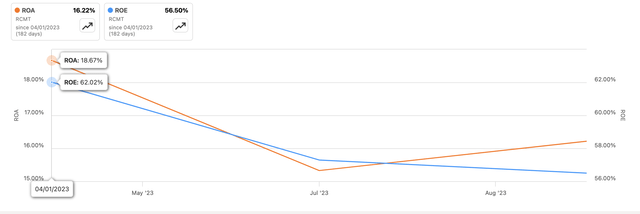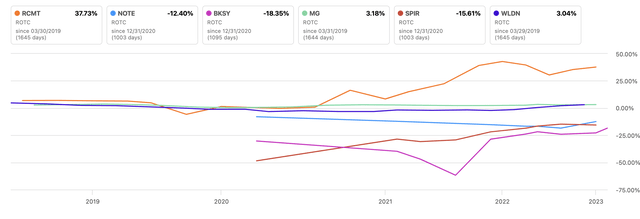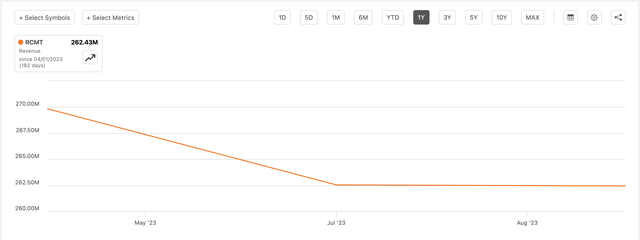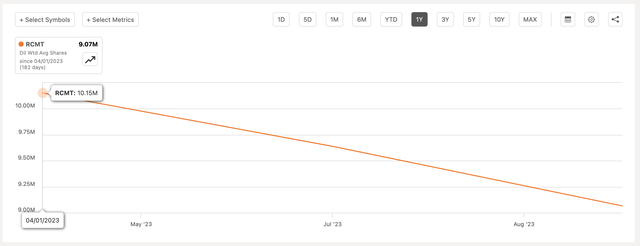FatCamera/E+ via Getty Images
Introduction
RCM Technologies (RCMT) is going to announce FY23 results on March 13th post-market (according to SA), so I wanted to check back in with the company and see how it has progressed throughout the year, and what to expect in Q4. The company’s financials have been relatively strong, with slight short-term deterioration in margins slowing down in revenues apparent. However, the management is excited about the future, and I believe the worst is behind. I am reiterating my strong buy rating and updating my PT.
Since my first article at the end of August, the company’s share price advanced around 37% against S&P500’s (SPY) 14%, so let’s see how the company progressed over the last year.
Briefly on Financials
As of Q3´23, the company had around $654k in cash and equivalents against $6.6m in long-term debt. I don’t think this amount of debt is particularly a problem for RCMT. The company generated very decent operating profit, which can easily cover annual interest expenses on debt. The company’s interest coverage ratio is around 16x, which is well over my minimum of 5x. So, the company still is at no risk of insolvency.
The company’s current ratio, however, went considerably down since the last time I covered it, and stood at around 1.08 as of Q3, down from around 1.5 at the end of FY22 due to transit receivables increasing dramatically. Nevertheless, the ratio is still over 1, which means the company isn’t in any liquidity problems. I would like to see the management tackling this, but I don’t think it´s a big issue. Let’s look at how the company’s margins progressed over the last year.
We can see a slight dip in profitability overall, which isn’t very big in my opinion, so the margins have been rather consistent and that is a good sign, even in a tough microenvironment like 2023.
Due to slight decreases in the bottom line, it’s no surprise that the company’s ROA and ROE have also followed suit. These are still rather good despite the declines, which we can see a slight bounce since Q2, at least in ROA. Nevertheless, the company is still very efficient at using its assets and shareholder capital, which should create value.
In terms of competition, the company doesn’t mention anyone in their 10K that would be a direct competition, so I will have to go with the default picks by SA to see how the company is doing. The company’s ROTC compared to the default selection of SA, is well above the rest, which tells me that the company is enjoying some sort of a competitive advantage and has a decent moat. Even without looking at the peers, the company’s high ROTC is very admirable, and well above the 10% that I look for in any investment, and such a number demands a premium in my opinion.
In terms of revenue, we can see a slight slowdown in 2023, which is understandable given the tough macro environment of high interest rates and sticky inflation, which is keeping a lot of businesses on edge. However, it seems that revenue declines have bottomed in Q2, however, we will have to see what kind of numbers the company will report this month, which I will cover in more detail in a later section.
Overall, the company has seen better days, however, the declines are not as bad as I saw in many other companies in 2023, so I think once uncertainties settle, the company will recover its growth potential and will see an upward trend returning. The company’s financial position is still relatively strong, and its efficiency and profitability metrics are still outstanding.
What to Expect from Q4
Analysts are expecting EPS to be $0.62 and $0.63 adjusted and GAAP, respectively, on $72.29m of revenue. This presents a decent sequential and y/y growth of around 37% and 31%, respectively. This tells me that margins are going to improve significantly across the board, while revenues will see a modest y/y growth of around 3%.
I believe what helped improve this number is that the company has repurchased quite a bit of its shares over the last year, which I would like to see continue.
Over the last 11 quarters, the company beat EPS estimates 10 times, while beating revenue 8 times.
The company usually doesn’t provide guidance. However, we can see that this time around, the company expects to see revenue between $70m and $74m, which is $72m at the midpoint, in line with analysts, while margins will remain consistent with Q3, which is also not bad, as long as they don’t see deterioration, I’m happy.
Overall, the management is very positive about the upcoming year, and the increases in revenues and no further deterioration in margins support the view that the bottom is set, and we should see growth returning going forward.
Comments on the Outlook
I would like to see the company add more schools to their portfolio that bring over 300k in revenue. As I mentioned in my previous article, the company had around 60 schools, with around 15 bringing in over 300k. When asked how many schools the company has under its wings now, the management said around 70. They did not mention how many more are accounting for 300k+ revenues, but I am assuming little to no change in this regard for now. I would like the management to give us what kind of growth they saw in this revenue segment and how good are they at converting the lower-revenue schools. Also, back in the first article, I mentioned that the company expects this market to grow 10x within the next 3 to 4 years, so I would like to know if this is still the case in their minds, because I think this is going to be hard to achieve. Specialty healthcare is still the top revenue contributor, so I would like to see revenue growth return to this segment going forward, as this segment saw the most declines in 2023, well the others stayed somewhat stable.
In terms of other segments, which account for roughly half of the company’s profits, I would like to see these remain steady or increasing, as I believe the highest difference to the company’s valuation will come from the rejuvenation of the healthcare revenue segment. The engineering and life sciences segment very well even in such a tough macro environment, which makes me believe that these will continue to perform as they have in the past or even better, once uncertainties in the economy fade.
Risks
The company cannot increase the number of schools in its portfolio and cannot convert more, which would bring in over 300k a year. This will certainly continue to weigh on the company’s top revenue contributor and will affect the company’s share price in the short run until we see substantial improvements.
The same risk still stands as I mentioned in the last article, which is the company is not well-known and daily trading volume isn’t very high, so expect volatility in either direction.
Further margin deterioration is not off the table, which is going to weigh on the company’s valuation. However, I am confident that when everything starts to improve, we will see these returning to their highs in no time.
Valuation
It’s been quite a while since I have done a valuation model on this company, so I went ahead and updated some assumptions and inputs that changed over time.
For revenue growth, I am keeping it quite modest, which will act as a margin of safety. The company managed to grow at an outstanding rate. However, the recent slowdown is not giving me hope right now, therefore, for my base case, I went with around 5% CAGR over the next decade. To cover my bases, I am also modeling a more conservative case and a more optimistic case. Below are those estimates, and their respective CAGRs.
In terms of margins and EPS, I modeled that the company would see some deterioration in FY23, which will gradually improve over time but not drastically, as I would like to keep it conservative. This will provide me with a further margin of error for my estimates. Below are those estimates, as compared to FY22.
Margins and EPS Assumptions (Author)
For the DCF model, I decided to use 10% as my discount rate instead of the company’s 7.5% WACC, which will give me even more margin for error/ margin of safety when it comes to the company’s intrinsic value. Furthermore, I went with a 2.5% terminal growth rate, and a further discount of 20% to the company’s intrinsic value, just to be completely sure that I am not overpaying to own the company. With that said, the company’s conservative intrinsic value is around $34 a share, which means the company is still trading at a decent discount to its fair value.
Closing Comments
So, it seems that the company is still trading at a decent discount after my model has been updated. Furthermore, I am increasing my fair value target from around $29.50 back in August of last year to around $34, and I am sticking with my strong buy recommendation as I believe the company has not reached its full potential yet.
I believe that the company’s margins will continue to improve, and its revenue growth should reaccelerate. Maybe not to the growth rates we saw in previous years, but will improve, nonetheless. My model expects low revenue growth going forward, so I think the downside of this is very low. Besides, I care about margin improvements much more than I care about top-line growth, but if the company can manage both, then it is undervalued by far and has plenty of room to grow.
I am looking forward to seeing the full-year results when the company announces them this month, and would like to hear what the management thinks about the future.











